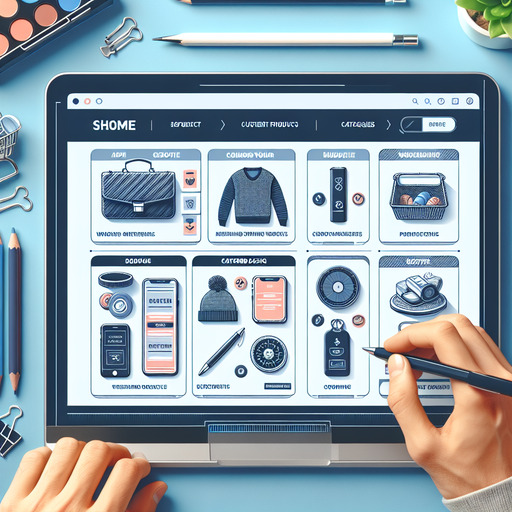
-
Table of Contents
Discover Stunning Web Design Inspiration for Your E-commerce Site! Get Inspired Now!
Introduction
In the rapidly evolving digital marketplace, the design of an e-commerce website plays a pivotal role in attracting and retaining customers. Web design inspiration for e-commerce sites encompasses a blend of aesthetics, functionality, and user experience to create visually appealing and highly efficient online stores. Effective e-commerce web design not only captivates visitors with its visual appeal but also ensures seamless navigation, quick loading times, and an intuitive shopping experience. By integrating the latest design trends, innovative layouts, and user-centric features, businesses can enhance their online presence, boost customer engagement, and drive sales. From minimalist designs that emphasize product showcases to dynamic interfaces that offer personalized shopping experiences, the right web design inspiration can transform an e-commerce site into a powerful tool for business growth and customer satisfaction.
Top 10 Web Design Inspirations for E-commerce Sites: Elevate Your Online Store with Custom Web Design and Responsive Web Design Trends
Creating an engaging and effective e-commerce site is crucial for any business looking to thrive in the digital marketplace. With the rapid evolution of web design trends, staying updated with the latest inspirations can significantly elevate your online store. Custom web design and responsive web design are two key elements that can make a substantial difference in user experience and conversion rates. Here are the top 10 web design inspirations for e-commerce sites that can help you create a visually appealing and highly functional online store.
Firstly, minimalistic design continues to be a powerful trend in e-commerce. By focusing on simplicity and clean lines, you can create a site that is easy to navigate and visually appealing. This approach reduces clutter and allows your products to take center stage, enhancing the overall shopping experience. Transitioning from minimalism, another trend gaining traction is the use of bold typography. Large, eye-catching fonts can draw attention to key messages and calls to action, making it easier for customers to understand your offerings and make purchasing decisions.
In addition to typography, incorporating high-quality visuals is essential. High-resolution images and videos can showcase your products in the best light, providing customers with a clear and detailed view. This is particularly important for fashion and lifestyle brands, where the visual appeal of products plays a significant role in the buying process. Moving forward, the integration of interactive elements can further enhance user engagement. Features such as 360-degree product views, zoom capabilities, and interactive size guides can provide a more immersive shopping experience.
Another critical aspect of modern web design is mobile optimization. With an increasing number of consumers shopping on their smartphones, ensuring that your site is fully responsive is no longer optional. A mobile-friendly design ensures that your site looks and functions well on all devices, providing a seamless experience for users regardless of how they access your store. Alongside mobile optimization, the use of micro-interactions can add a layer of sophistication to your site. These small, subtle animations can guide users through the shopping process, making it more intuitive and enjoyable.
Furthermore, personalized user experiences are becoming increasingly important. By leveraging data and analytics, you can tailor the shopping experience to individual users, offering personalized product recommendations and content. This not only enhances user satisfaction but also increases the likelihood of conversions. Transitioning to another trend, the use of storytelling in web design can create a deeper connection with your audience. By sharing the story behind your brand and products, you can build trust and loyalty among your customers.
Moreover, the integration of social proof elements such as customer reviews, testimonials, and user-generated content can significantly boost credibility. Potential buyers are more likely to trust and purchase from a site that showcases positive feedback from real customers. Additionally, the use of vibrant color schemes can make your site stand out and evoke specific emotions, influencing purchasing behavior. Carefully selected colors can highlight important elements and create a cohesive brand identity.
Lastly, ensuring fast load times is crucial for retaining visitors. A slow-loading site can frustrate users and lead to higher bounce rates. By optimizing images, leveraging browser caching, and minimizing code, you can improve site speed and provide a smoother shopping experience.
In conclusion, staying abreast of the latest web design trends and inspirations can greatly enhance your e-commerce site. By incorporating elements such as minimalistic design, bold typography, high-quality visuals, interactive features, mobile optimization, micro-interactions, personalized experiences, storytelling, social proof, vibrant color schemes, and fast load times, you can create a compelling and effective online store that stands out in the competitive digital landscape.
Q&A
**Question:** What are some effective sources for web design inspiration specifically for e-commerce sites?
**Answer:** Effective sources for web design inspiration for e-commerce sites include:
1. **Awwwards** – Showcases award-winning web designs.
2. **Behance** – A platform where designers share their projects.
3. **Dribbble** – A community of designers sharing screenshots of their work.
4. **Pinterest** – A visual discovery engine with a plethora of design ideas.
5. **SiteInspire** – A curated gallery of the best web design inspiration.
6. **Commerce Cream** – Features beautifully designed e-commerce websites.
7. **Muzli** – A Chrome extension that provides daily design inspiration.
8. **Land-book** – A collection of the best landing page designs.
9. **Ecomm.design** – A showcase of e-commerce websites from around the world.
10. **Designspiration** – A hub for discovering and sharing design ideas.